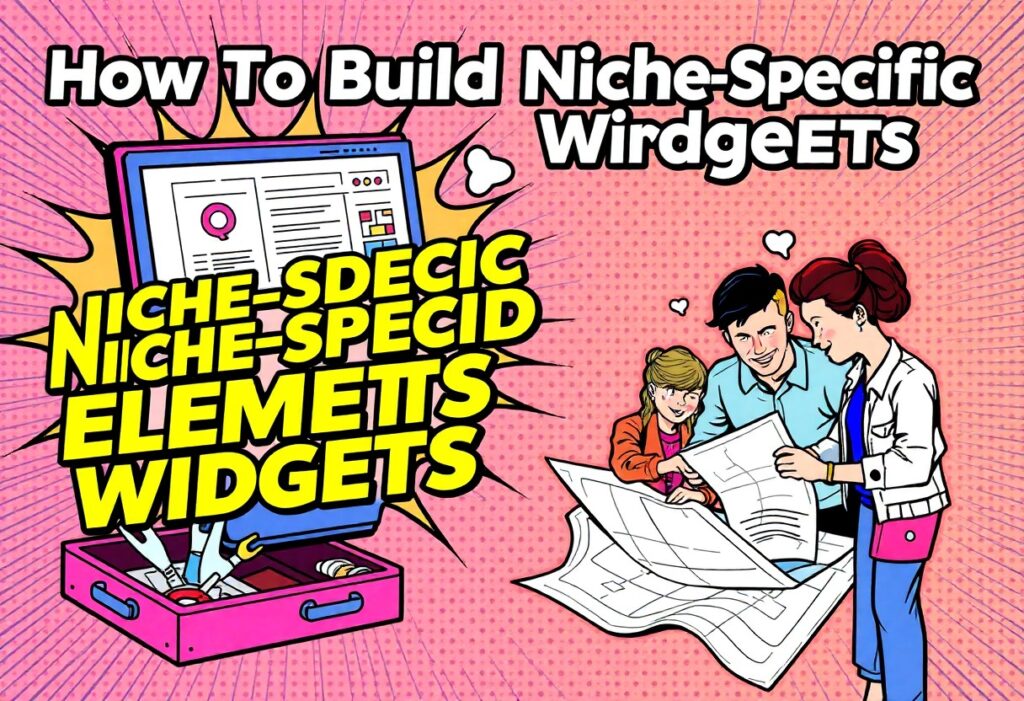Crafting Your Vision: The Importance of Niche-Specific Widgets
Understanding Your Audience’s Needs
Creating niche-specific widgets enables you to tailor your website tools to the unique demands of your audience. Consider a small business that specializes in vegan meal prep. By implementing a widget that offers customizable weekly meal plans, recipes, shopping lists, or even a calorie tracker, you not only enhance user experience but also establish a deeper connection with your target audience. Research shows that websites offering personalized interactions improve user engagement rates by up to 60%, significantly increasing the likelihood of conversions.
Maximizing User Engagement
Effective niche-specific widgets drive user interaction and retention by providing targeted solutions. For example, a real estate agent could benefit from a mortgage calculator or a property comparison tool tailored specifically for first-time homebuyers. Such widgets address common inquiries while simplifying decision-making processes, easing user frustration. A study by HubSpot revealed that businesses leveraging interactive content like calculators see up to 2.5 times higher engagement rates than those who don’t. By crafting widgets that align directly with your audience’s specific interests and challenges, you’re not just creating tools; you’re fostering a community that relies on your expertise.
Assessing Market Gaps: Identifying Niche Opportunities
To effectively carve out your niche in the crowded plugin market, the first step involves thoroughly examining existing offerings. You should start by evaluating competitor widgets, which allows you to understand what works and what doesn’t. Take note of the features that garner high user ratings or rave reviews. Investigate aspects where competitors fall short, such as usability issues, lack of customization, or inadequate support. For instance, if several plugins fail to adequately address mobile responsiveness, that gap can serve as a launching point for your unique proposition. Recognizing these shortcomings plays a vital role in informing your widget development and ensuring you’re creating a solution that genuinely adds value.
Analyzing Competitor Widgets
Start by creating a list of the most popular Elementor widgets within your target niche. Look at user reviews and ratings on platforms like WordPress.org or third-party marketplaces. If a significant number of users complain about certain features, that indicates a potential opportunity for improvement. For example, if you find that users frequently mention a lack of integration with popular APIs, there’s a clear signal that addressing such compatibility issues could set your widget apart. Additionally, take cues from competitor pricing strategies—offering better value or bundling features could be a game-changer.
Surveying Your Target Audience’s Needs
Understanding what your audience truly desires can inform your widget design and functionality. Conduct surveys, utilize social media polls, or engage directly in community forums to gather insights. Find out the specific challenges users face with their current solutions and which features are most desired. Pay attention to requests for functionality that may still be missing in existing widgets. For instance, if you find that developers often request a specific type of shortcode compatibility or layout flexibility that competitors lack, incorporating those elements can position your widget as the go-to solution.
Dive deeper into how your target audience interacts with existing Elementor tools. You can use platforms like Typeform or Google Forms to create detailed surveys that focus on user pain points, preferences, and desired features. Gathering this qualitative data enables you to craft a widget that doesn’t just fill a gap but also preempts users’ needs, setting you ahead of the competition. Analyzing feedback through these channels can not only provide clarity on important functionalities but also build a community around your emerging product as your audience feels heard and valued.
Tool Choosing: Leveraging Elementor for Custom Widgets
Key Elementor Features for Widget Creation
Elementor offers a robust set of features that streamline the process of widget creation, making it an ideal tool for those looking to develop niche-specific solutions. The drag-and-drop interface allows you to design your widgets visually, as each component can be added or adjusted intuitively without delving deep into code. The ability to customize with responsive controls ensures your widgets look great on any device, providing a seamless user experience. In addition, the rich style options let you personalize your widgets extensively, aligning them with your brand’s aesthetics and the specific needs of your target audience.
Utilizing Elementor’s template library can further enhance your workflow by allowing you to reuse designs across different widgets. This not only saves time but also ensures consistency in your design elements. With capabilities like dynamic content integration, you can pull in data from WordPress and other sources, making your widgets more interactive and relevant to your users. This combination of features empowers you to craft unique, effective widgets tailored specifically for your niche.
Essential Plugins to Enhance Functionality
While Elementor is powerful on its own, leveraging specific plugins can unlock even greater functionality for your custom widgets. Plugins like Advanced Custom Fields (ACF) enable you to create custom fields that enhance data collection and display, allowing you to tailor content precisely to your audience’s preferences. Another valuable addition is the Elementor Custom Widgets plugin, which facilitates the creation of bespoke widgets by helping you bypass standard limitations and create unique functionalities without extensive coding knowledge.
Other notable plugins, such as Elementor Extras, present a suite of additional widgets and extensions that can enrich your designs. By integrating these plugins with Elementor, you expand your toolkit for creating specialized widgets, giving you flexibility in both design and functionality. Each plugin addresses specific gaps, enhancing your development process and putting previously unavailable capabilities at your fingertips.
Incorporating these important plugins not only simplifies your widget creation process but also elevates your final product. With added functionality, you can implement features like advanced animations, improved user interactivity, and intricate layouts that keep users engaged. The integration of these tools creates a sophisticated ecosystem where your widgets can truly shine, maximizing the potential of your niche-specific designs.
Step-by-Step Guide to Building Your First Widget
| Step | Description |
|---|---|
| 1 | Set Up Your Development Environment |
| 2 | Code Custom Elements with Elementor’s API |
| 3 | Style Your Widget for Appeal and Usability |
Setting Up Your Development Environment
To start building your widget, you first need a suitable development environment. Install a local server environment like XAMPP or Local by Flywheel, which allows you to run WordPress on your machine. After setting it up, create a new folder in the ‘wp-content/plugins’ directory that’s dedicated to your widget. This is where all your files, including your PHP script and any assets, will reside.
Next, create a plugin file – name it according to your widget project. Within this file, you’ll include the standard plugin header, which outlines the name, description, and version. Activate your plugin in the WordPress dashboard under the Plugins menu. Doing this establishes the foundation for your custom widget, enabling you to test functionality quickly and ensure that everything works seamlessly as you develop.
Coding Custom Elements with Elementor’s API
Using Elementor’s API, you can create and customize widget elements that cater to your niche. Begin by hooking into the ‘elementor/widgets/widgets_registered’ action to register your widget class. You’ll then define functions that specify the widget’s controls and render its output based on user input. Think of this as crafting a highly specialized tool that meets specific demands, informing your coding choices based on your audience’s expectations.
Elementor’s API provides comprehensive documentation, allowing you to dive deeper into widget functionality. For instance, by leveraging the available controls, you can enable users to customize every aspect of how your widget appears on their site, resulting in a dynamic user experience. Consider implementing features that reflect the unique aspects of the niche you’ve identified, such as specialized typography settings or color palettes.
Styling Your Widget for Appeal and Usability
With your widget code in place, turn your attention to styling. Utilize CSS and Elementor’s built-in styling options to enhance user interaction. Be mindful of responsive design practices by ensuring that your widget looks appealing across all devices. It’s about crafting a user-friendly experience where functionality meets aesthetics, enticing users to engage with the content while easily accessing all features.
Employing a consistent color scheme and typography strong enough to reflect your niche will create a unified experience on the site. Using margin and padding wisely can also help maintain visual harmony between your widget and the surrounding elements. Ultimately, a well-styled widget prioritizes both visual appeal and usability to attract and retain users.
By meticulously styling your widget, you elevate its performance and ensure it resonates with the specific audience you targeted earlier. This deliberate approach not only enhances the overall appearance but also encourages users to incorporate the widget seamlessly into their existing design, reinforcing brand identity and user satisfaction.
Optimization Strategies: Ensuring Functionality and Performance
Functionality and performance considerations are vital components in the creation of niche-specific Elementor widgets. Prioritizing optimization from the outset streamlines the user experience, ensuring that visitors engage with your content rather than waiting for it to load. Utilize techniques such as code minification and image optimization to enhance load times, thus improving your overall SEO. Tools like GTmetrix or Google PageSpeed Insights can be invaluable in identifying areas of improvement—such as reducing server response times or eliminating render-blocking JavaScript.
The use of lazy loading for images and videos can significantly enhance performance, especially for widgets that display multimedia content. A well-structured widget won’t just benefit end-users; it also ensures compatibility with various devices and browsers, as performance discrepancies will lead to a fragmented user experience. Employing best practices in coding and adherence to WordPress standards elevates your widget’s reliability and ease of use.
Testing Your Widget Across Devices
Testing your widget across multiple devices is non-negotiable to ensure a seamless experience for all users. Consider that mobile traffic is estimated to constitute over 54% of global website traffic. As such, you must confirm that your widget is responsive and functions properly on both mobile and desktop environments. Use browser developer tools to simulate various screen sizes, and if possible, try testing on actual devices to glean insights on usability and visual appearance.
Beyond basic functionality, consider the interaction design; ensure that touch events are adequately supported for mobile users. A widget that looks great on a desktop but fails to respond intuitively on a smartphone can lead to frustration and loss of engagement. Always prioritize thorough testing at every stage of development to pinpoint any issues before deployment.
Gathering User Feedback for Continuous Improvement
User feedback acts as a compass for continuous improvement, guiding you toward refining your widget’s features and functionality. Actively seeking feedback through methods such as surveys can provide insights into user satisfaction and highlight areas for enhancement. Establishing a dedicated feedback mechanism, either within your WordPress site or utilizing external services, allows users to voice their thoughts easily, thereby contributing to a more user-centric widget evolution.
Encouraging user feedback can hinge upon incentives. Providing an opportunity for users to participate in beta testing, offering discounts, or even featuring user testimonials prominently can bolster response rates. Analyzing user feedback not only enhances the performance of your widget but also builds a community around it, fostering loyalty and repeat engagement. Establish regular intervals for revisiting and applying feedback, which keeps your widget dynamic and in tune with user expectations.
Launch and Market Your Unique Widget
Crafting a Compelling Product Description
Your product description serves as a persuasive narrative that captivates potential users and drives sales. Focus on the key benefits your widget provides to address specific pain points within your target niche. Highlight features that set it apart, using clear and engaging language. Techniques such as storytelling or providing a use-case scenario can help potential customers visualize how your widget solves problems. Use bullet points for easy reading and include keywords that users may search for, optimizing your description for search engines.
Providing visuals is another effective way to enhance your product description – include screenshots, videos, or GIFs demonstrating your widget in action. Showcasing user testimonials or case studies can establish credibility and trust, persuading visitors to take a leap and try your product. Additionally, emphasize any unique selling propositions, such as compatibility with popular themes or superior customer support, to highlight why your widget is the go-to solution for their needs.
Leveraging Social Media and Communities for Promotion
Utilizing social media platforms effectively can expand your reach and create buzz around your widget. Share engaging content related to your widget’s purpose, such as tips, tutorials, or behind-the-scenes snippets of its development. Engage with users on platforms such as Facebook, Twitter, Instagram, and LinkedIn, where potential customers congregate. Participating in niche-specific groups or forums can also create opportunities for organic promotion. Don’t hesitate to ask fellow members for feedback or suggestions; cultivating meaningful interactions can organically promote your widget.
Consider running targeted ads on social media that speak directly to your audience’s interests. Platforms like Facebook Ads allow precise targeting based on user demographics, behaviors, and interests, ensuring your message reaches those most likely to convert. Collaborating with influencers who are trusted voices within your niche can also amplify your promotion efforts. Their endorsement can lead to heightened visibility and credibility for your widget, resulting in increased install rates and sales.
In summarization, the marriage of a well-crafted product description and a strategic social media promotion plan can effectively launch your widget into the spotlight. By emphasizing the unique aspects of your widget and engaging with the right audience, you will lay a solid foundation for successful market entry.
Conclusion
As a reminder, creating niche-specific Elementor widgets not only enhances your design capabilities but also allows you to cater to a particular audience more effectively. By understanding the specific needs of your users and leveraging Elementor’s robust features, you can craft widgets that add significant value to their experience. Your ability to focus on these tailored solutions will not only set you apart in the competitive landscape but also establish your authority as an expert in your niche. Hot, engaging widgets can lead to higher user satisfaction and increased engagement on your website.
As you continue to develop your skills in building these custom widgets, be sure to test and iterate based on user feedback. Constantly refining your approach will help you become adept at meeting the evolving demands of your audience. By committing to this process, you will not only improve your offerings but also build a stronger community around your brand. Embrace the learning curve and let your creativity thrive, ensuring that each widget you create contributes positively to your greater design goals and objectives.
FAQ
Q: What are niche-specific Elementor widgets and why are they important?
A: Niche-specific Elementor widgets are custom-designed elements tailored to meet the unique needs of a specific market or audience. These widgets enhance user engagement by providing features that cater directly to the interests and requirements of that niche. For instance, a real estate widget might include property listing displays, search filters, and an interactive map, making it more relevant and user-friendly for visitors in the real estate sector. By using niche-specific widgets, you can improve the overall functionality of your site and create a more personalized experience for your users, ultimately leading to higher conversion rates.
Q: How can I build my own niche-specific Elementor widgets?
A: To build your own niche-specific Elementor widgets, you need to have a basic understanding of WordPress development, particularly PHP, HTML, CSS, and JavaScript. Start by setting up a child theme or a custom plugin where you can add your widget code. Utilize the Elementor Plugin Developer Resources, which provide comprehensive guidelines on creating custom widgets. Begin by defining the widget’s settings and controls, implementing the UI using Elementor’s API, and ensuring the widget is responsive. Testing will be vital, so check that it functions properly across different devices and browsers. After building, you can use Elementor’s interface to add it to your pages seamlessly.
Q: What are some best practices for designing niche-specific Elementor widgets?
A: When designing your niche-specific Elementor widgets, focus on the following best practices: first, conduct thorough research to understand the specific needs and preferences of your target audience. Ensure the design aligns with your brand identity and is visually appealing. Maintain consistency in usability, allowing users to easily navigate and interact with the widget features. Optimize your widget for speed and responsiveness; ensuring that it loads quickly and functions properly on both desktop and mobile devices is critical. Lastly, gather user feedback after launch to make necessary improvements and updates, enhancing the overall performance of your widget.




